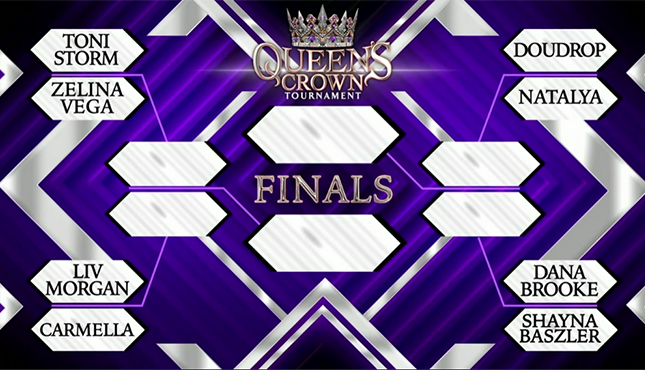wrestling / Columns
WWE Queen’s Crown Tournament Highlights a Concerning Trend

Eight minutes and 12 seconds.
For those keeping score at home, that was the combined match time of the four first round WWE Queen’s Crown Tournament matches – give or take a few seconds here or there.
Congratulations to Zelina Vega, Carmella, Doudrop, and Shayna Baszler, all of whom advanced to the semifinals.
Unfortunately, there’s little reason to congratulate WWE for its part in this tournament thus far, or the concerning direction of the women’s division.
The change in direction won’t sit well for fans who’ve watched women’s wrestling evolve from Bra and Panties matches to competitive wrestling matches. The Queen’s Crown tournament was seen as an opportunity to further the evolution of that concept, though there’s nothing too competitive about two-minute matches.
But it’s more than just short matches. It’s one of WWE’s biggest problems staring it right in the face:
How do you create new stars – while also improving the women’s division – with current booking trends?
Consider the following stats, courtesy of the fine folks at Cagematch:
Toni Storm was called up to the WWE main roster in July. Since that time, she has wrestled in only three televised matches for a whopping total of seven minutes of in-ring competition.
Vega, who returned in July, has won two of the eight televised matches she’s been involved in – one of those being her victory over Storm, who in one of her three matches, beat Vega.
Liv Morgan – arguably in the most pushed spot of her career – had won four of her last five televised singles matches before losing to Carmella, an opponent she’s now had seven singles matches with since June, in one minute and 40 seconds in Queen’s Crown.
Carmella had not won a televised WWE match since June 4 before defeating Morgan in one minute and 40 seconds. That previous win come against – you guessed it – Morgan in two minutes and 30 seconds.
Doudrop has actually been the most protected of the eight competitors with a 4-3 record in singles matches since August, though she was fresh off a sub-two-minute loss to Charlotte Flair (I know, it was a distraction finish, but still).
Natalya has now lost seven straight matches – four of which came while she was one half of the WWE Women’s Tag Team Champions – since August.
Dana Brooke has not won a singles match since defeating Peyton Royce on Main Event in February, and has had only four televised matches since May.
And then there’s Baszler, who prior to her restart push on September 20, had not won a televised singles match since defeating Lana in February. She lost to Reginald in May.
Do any of those stats represent a realistic approach to creating new stars? Or is it even an approach that’ll keep fans fully invested in characters who aren’t slotted in top roles?
Technically, WWE could make one of the four remaining competitors a bigger star if it pushes all of the right buttons. But why should that be the expectation after what fans were treated to with the first half of the tournament?
And what if that was the goal from the very beginning, instead of Vega and Carmella consistently losing week after week, Doudrop being cast into a bizarre role right off the bat, and Baszler’s up-and-down push in yet another “can they co-exist” tag team with Nia Jax?
However, the problem goes beyond the Queen’s Crown Tournament.
Is any women’s wrestler on the main roster truly at the highest point they’ve ever been in with WWE?
Becky Lynch turned heel despite being the most over babyface in the company. Bianca Belair hasn’t won a televised WWE match by pinfall since August 27. Flair and Sasha Banks are stars, but is their star as bright as it once was? Rhea Ripley and Nikki A.S.H. are, yep, trying to co-exist. And the list goes on and on.
The Queen’s Crown Tournament isn’t simply about bad booking. It’s about a series of decisions over time that has led to the current state of the WWE women’s division – one that, not long ago, was better than ever.
In a period where AEW, Impact, Ring of Honor, STARDOM, Mission Pro Wrestling, the returning WOW, and many more all seem to be intent on pushing women’s wrestling forward, WWE appears to be going in the opposite direction. And it’s not a talent issue.
With a more focused and intentional effort, that trend can be fixed.
But after eight minutes and 12 seconds, the focus and the intent seem to be telling a different story.
*For more of my thoughts on pro wrestling, subscribe to the 411 On Wrestling podcast and follow me on Twitter @wrestleblake. Thanks for reading!
More Trending Stories
- Janel Grant Spokesperson Criticizes Rock, John Cena For Staying in Touch With Vince McMahon
- Oklahoma Athletic Commission Gives AEW ‘Warning’ Over Nyla Rose Match, Rose Responds
- Update on Life for Vince McMahon Post-WWE, Maintaining Contact With Donald Trump, WWE Employees Less Fearful Now
- Eric Bischoff Praises Kenny Omega, Thinks AEW Made Mistake With Mercedes Mone







